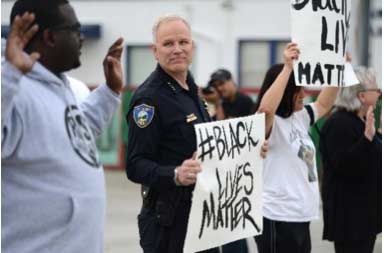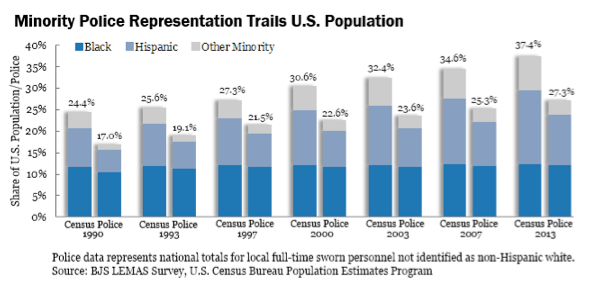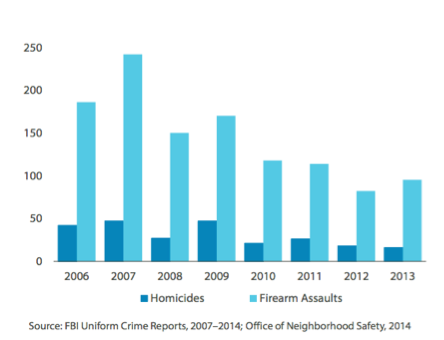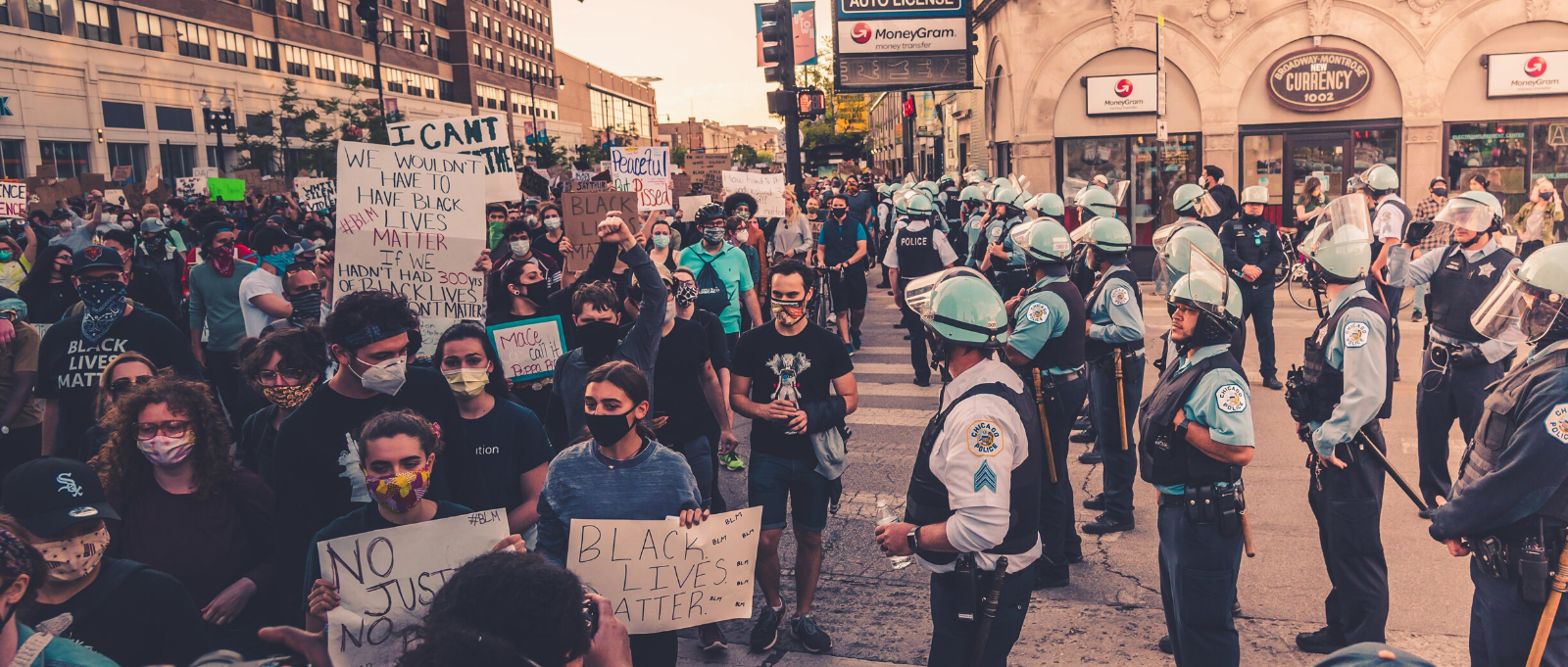July 1, 2016
Topic
“I reject the idea that these issues are somehow too big for us — that America is too divided to find common ground…I know that we can honor the incredible courage and service of our police officers — and also recognize the racial disparities that exist in our criminal justice system.”
– President Obama
2016 has been another year fraught with social turmoil and outbursts of violence. Controversial police shootings have fueled historical racial tensions and increasing outrage over generational problems of structural poverty, growing income inequality, civic disenfranchisement and disinvestment.
On the other end of the spectrum, the tragic shootings of police officers in Dallas and Baton Rouge simultaneously underline the interconnected vulnerability of a public-safety system that isn’t sufficiently protecting our community members – police officers and residents alike.
Beyond the profound sadness for the families of the lost and injured, these troubling incidents raise a number of deeper concerns about racial profiling, the safety of public servants and the community relationships between police officers and the residents they are paid to protect.
And it isn’t as simple as pointing to increased crime as the source of increasing social volatility. In fact, national crime rates have been declining – violent crime has fallen by 51 percent since its peak in 1991, and property crime is down by 43 percent.
Diversity, or lack thereof, on the police force (by race, gender and sexual orientation), recruitment and hiring practices, and police training and procedures are core factors that can have significant impacts on the level of trust between officers and residents – and on subsequent treatment across races.
Data are hard to collect on fatal police shootings, but according to a ProPublica analysis of federally collected data, young black males in recent years were at a far greater risk of being killed by police than their white counterparts – 21 times greater – although the total number of white males killed was higher. The Washington Post quoted the number of unarmed black men as seven times more likely than whites to die by police gunfire.
Regardless of the racial component, the context of the neighborhood or the strength of community relationships with police, police training and procedures need to address the fact that far too many people are being unduly and unjustly shot.
There are many issues we can explore around racial inequity and crime, but for the purposes of this article we will focus on improving police relationships with community members so that all residents, especially those with the greatest obstacles to overcome, can feel safe in their communities.
Case Study: Richmond
Not long ago, the California city of Richmond was considered one of the most dangerous cities in America. With a skyrocketing homicide rate fueled by gang activity, many residents distrusted the police department with its decades-old reputation of racism and hard-handed responses.

City Manager Bill Lindsay believed that an overhaul of police practices would be critical to improving the safety and livability of the community. He turned to Chris Magnus, former police chief of Fargo, ND. A decade later, this minority-majority city has recorded its lowest homicide rate in more than 30 years. Magnus left the position recently, after spending a decade transforming public safety in Richmond, to serve as police chief in Tucson.
One of Magnus’s first changes was to switch to neighborhood-based policing. Neighborhood-based or “community policing” is a philosophy of law enforcement that moves away from a strict hierarchical system and stresses more direct officer involvement with local citizens. Community policing puts officers closer to the root causes of neighborhood crime, where they can be better addressed.
Officers started attending neighborhood meetings and gave out their mobile phone numbers, so they could be reached and in turn respond more quickly. The department installed monitored street cameras and a gunfire detection system and employed sophisticated software to better predict and prevent crime.
Community policing helped to improve trust but Magnus had to address another core reason many community members feel disconnected from the police- officers in many areas don’t look like the communities they serve. Across the U.S., minority police representation hasn’t kept pace with the growing diversity of our communities – women and members of the LGBT community haven’t been sufficiently represented either.
Whether fostering relationships with community members or overcoming language barriers that arise when police are called to a scene (and can’t wait for translators to arrive) lack of diversity can impact day-to-day interactions and erode trust. It can also put departments at a recruiting disadvantage because officers can be an agency’s best recruiters.

This was true in Richmond, where Latinos and African-Americans comprise the majority of the population. Magnus worked to improve the diversity of Richmond’s police force and by the end of 2014 about 60% of Richmond’s 182 active police officers were black, Latino, Asian or Native American; about 40% were white; and there were 26 female officers on the force.
Soon after Magnus started, the City brought on community activist DeVone Boggan who designed a number of programs aimed at reducing gun violence in the city.
Boggan and his team launched the Operation Peacemaker Fellowship. They identified the 17 people responsible for 70% of the firearm activity in Richmond and several more, and made them an offer. The fellowship would provide them with counseling, social services, a job and a chance to travel if they developed a “life map,” and agreed to stay in contact every day, and stay out of trouble. The fellowship would then pay them up to a $1,000 a month for nine months.
A recent evaluation by the National Council on Crime and Delinquency found that the program seems to be working for most of the people who buy into it. Richmond has seen its murder rate cut in half since the fellowship began.
This street outreach is just one part of a broader program designed by Boggan, the former director of the Office of Neighborhood Safety.

It is the combination of reforms – better training (the City brought on a national expert on recognizing implicit racial and gender bias to conduct a department-wide training in February, for example), community policing and new supportive technologies – that truly set Richmond apart and could prove to be a model for other departments large and small.
Things certainly aren’t perfect in Richmond but as U.S. Attorney General Loretta Lynch said on her visit to Richmond last September, “From what I have seen in Richmond today, and from all that I have observed in the cities I have visited on this tour, I am more confident than ever that positive change is possible.”
Takeaways
The following recommendations from the President’s Task Force on 21st Century Policing can help improve police-community relations and institute community-centered policing at the local level. They can help build mutual trust and respect, increase safety in communities, and minimize senseless killings by police officers and community members alike.
Ensure Transparency and Accountability: Departments should establish enforceable, transparent and impartial accountability measures in instances where police brutality, racial profiling, and/or improper use of force are in question. This includes establishing effective and independent review boards broadly representative of the community, not just police interests.
Invest in Training: Law enforcement personnel should undergo racial bias training in addition to building skills that exemplify problem-solving strategies, conflict-mediation techniques, and de-escalation tactics. Officers should become adept at responding to community needs, and achieving consistency and continuity in engaging community while enforcing the law.
Ensure Diversity: Police department personnel should be representative of the communities they protect and serve. Therefore, police departments should adopt personnel practices that result in the hiring and retention of diverse professionals who are culturally sensitive, speak the communities’ languages, and are reflective of the residents in the communities they patrol.
Proactively Engage Communities: Police departments should work to deconstruct stereotypes and bias by identifying regular opportunities for constructive and quality engagement with youth and others living in the communities they serve. Departments should partner with communities in solving and preventing problems before they occur.
Reject Militarization: Departments should not rely on military equipment and tactics to police everyday problems or peaceful protests.
Examine and Implement Good Models: Every department should partner with other local, state and federal entities to quickly identify and establish new policies and practices to improve policing in communities.
Implement Technology and Tools for Oversight: Departments should implement technology that helps to investigate and hold officers accountable for misconduct. All information gathered by the use of technology should be made publicly accessible immediately.





